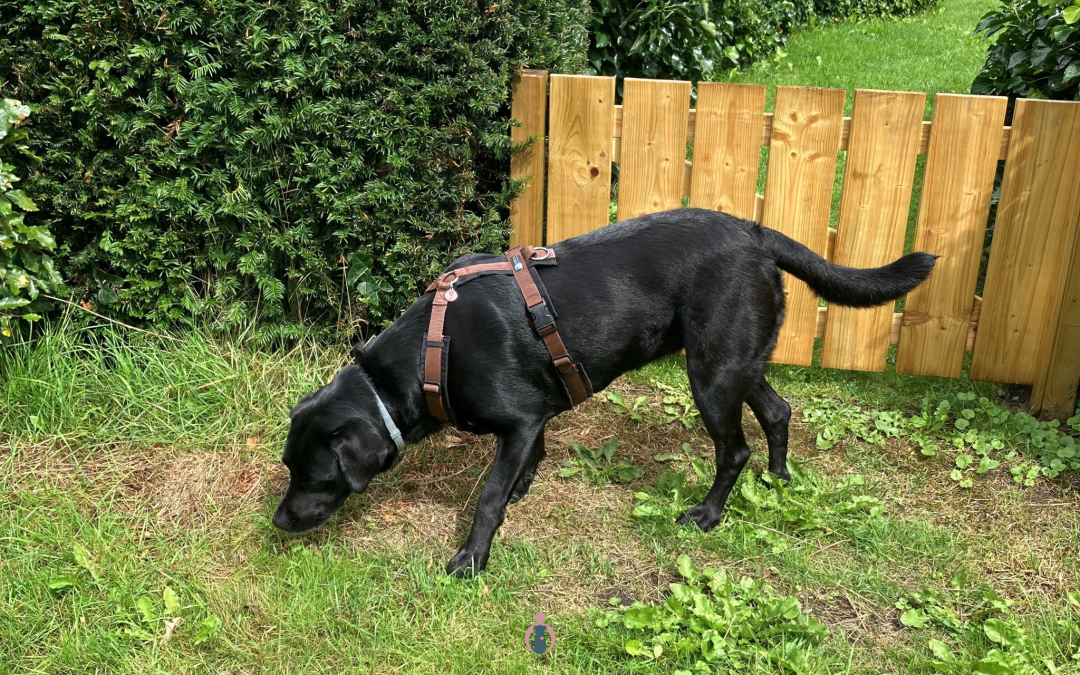As soon as spring arrives, you suddenly see it everywhere: dogs rooting around fields with their noses and selecting grass blades with careful precision. Not just casual nibbling in passing, but really searching for the right bit of green. And perhaps you’ve wondered why your dog does this too. Is he missing something in his diet? Doesn’t he feel well? Is this normal?
The good news: eating grass in spring is completely normal dog behaviour. In this blog I’ll explain why many dogs do this, why you usually don’t need to worry, and what you might want to watch out for.
Eating grass doesn’t necessarily mean your dog doesn’t feel well
There’s a persistent myth that dogs eat grass to make themselves vomit. And yes, under certain circumstances that’s true. Sometimes dogs do indeed vomit after eating grass—often when they wolf it down in large quantities or very hastily. However, with the grass eating that occurs in spring, it usually unfolds quite differently.
Many dogs take their time calmly, sniff attentively, and deliberately eat mainly the soft tips of young grass. No stress, no hasty chewing, and especially: no vomiting. It looks more like a conscious snack than the frantic, intense grass eating of a dog with a tummy ache.
Why specifically that young grass?
Young grass is nutritious and attractive
Young grass blades in spring are surprisingly rich in nutrients. During this phase of rapid growth, the grass absorbs lots of nitrogen from the soil, which leads to higher levels of amino acids and therefore proteins. And that makes the first spring grass attractive for many grazing animals—and, apparently, also for our dogs.
Additionally, young grass contains relatively high amounts of soluble sugars, such as fructans. This provides a slightly sweet taste, which makes the grass even more attractive. The combination of soft texture, a bit of sweetness, and high nutrient content makes it simply irresistible for many dogs.
Young grass also scores well in terms of micronutrients: it contains vitamin C, folic acid, B-vitamins and chlorophyll amongst other things — the green pigment that plants use for photosynthesis (the process whereby sunlight is converted into energy). Chlorophyll is known in natural medicine for its cleansing effect on the body. And that brings us to another possible, interesting perspective.
A spring detox for dogs?
According to Traditional Chinese Medicine, spring is the season of the Liver and Gallbladder — organs associated with movement, renewal, and cleansing. After winter, when everything comes to rest and energy is stored, spring is the moment when the body begins to move again. Cleansing and releasing what’s no longer needed, both physically and emotionally.
From this perspective, it’s not inconceivable that dogs instinctively search for foods that support this process. And grass — particularly young grass rich in chlorophyll — fits perfectly into that picture. Perhaps dogs sense that their body is ready for a cleanse, and instinctively choose something green and fresh.
Animals and their natural wisdom
Anyone who delves into the behaviour of animals in the wild sees examples of instinctive self-care everywhere. Parrots eating clay for extra minerals. Cats seeking out specific plants for tummy troubles. Monkeys using leaves with medicinal properties.
Dogs and wolves in the wild also regularly eat plant material. Not only through the stomach contents of their prey, but also directly from plants: berries, herbs, grasses. Our house dogs still have those instincts within them, though they may be somewhat less pronounced. Moreover, our dogs, due to their lifestyle with us and their dependence on where we take them, may not always have access to the herbs and plants they would like to eat.
This makes spring grass not just a snack, but perhaps also an expression of natural self-regulation.
The ‘grass blade incidents’
Anyone who has ever had to pull a grass blade from their dog’s rear end knows that grass isn’t always digested elegantly. Dogs’ digestive systems aren’t designed to completely break down fibrous plant material. And so it can happen that a blade sticks out one end, whilst the other half is still… well, en route. The dog looks unhappy, and often can’t manage to get that blade out under their own steam. But fortunately, you’re there, as a rescuer in this grass blade emergency!
Such a ‘grass blade incident’ may be somewhat awkward — for both dog and owner — but is usually completely harmless. All you need is a bit of helpfulness, a tissue or a poo bag, and a sense of humour. 😉
When should you pay attention?
In most cases, grass eating is harmless and simply part of spring. However, there are situations where it’s wise to be alert:
- If your dog regularly eats grass and then vomits — this could indicate stomach problems or nausea.
- If the grass eating seems compulsive — for example when your dog wolfs down large quantities of grass in a short time.
- If the behaviour suddenly changes — for example a dog who normally never eats grass and suddenly starts doing so obsessively.
- If your dog eats grass in unsafe places — think of grass alongside busy roads (contaminated with exhaust fumes) or in fields that may have been sprayed with fertilizer or pesticides.
In short: keep observing and stay alert, but don’t worry too quickly.
In conclusion
Eating grass in spring is behaviour you see in many dogs. It’s natural, it’s seasonal, and it’s usually no cause for concern. Perhaps your dog simply finds it tasty. Perhaps he senses that his body needs something light, something cleansing. As long as you pay a bit of attention to where your dog gets his green snack from, there’s nothing wrong with a grass blade or two.
Enjoy spring, together with your dog!
If you enjoyed this blog, or the accompanying podcast, I would love it if you would share it with other dog lover’s, or on your social media 🙏
If you would like to support your dog in other ways for a healthy and vital lifestyle, please check out my ebook Bowl Boosters!
There you’ll find 10 superfoods with which you can boost your dog’s daily nutrition. Most of them are easily found in supermarkets or health food stores, no complicated or exotic ingredients. Just simple, daily extras to boost your dog’s health and vitality!
You can find it HERE.


 Want to receive 5 tips for your senior dog in advance?
Want to receive 5 tips for your senior dog in advance?